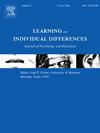定义标准化考试指令的外部监管:数字世界中学生学业成功的关键变量
IF 9
1区 心理学
Q1 PSYCHOLOGY, EDUCATIONAL
引用次数: 0
摘要
在学校环境日益数字化的背景下,确定教育者的外部监管程度是我们在未来学生学习中面临的最重要问题之一。教育工作者必须决定如何建立学习环境和提供多少指导,以激发学生的最佳表现。认知能力的标准化测试评估提供了一个重要的参考点,用于操作考官在管理这些测试时的结构和方向的程度可能与学生表现的个体差异有关。我们对几种不同认知评估方法的标准化指导进行了分析,说明了这些评估在外部调节程度上的差异,例如物理环境设置的规格、提供的指导和反馈的数量、管理期间考官的指导和时间因素。基于识别和量化这些因素的编码方案,我们通过检查外部调节程度是否可以解释测试表现的个体差异,特别是在高危学习者(如患有ADHD的儿童和青少年)中,提出了概念证明。将我们多年来提炼标准化考试管理指导的经验付诸实践,可以作为在数字化学习环境中确定优化学生学习的因素的有用参考点。教育相关性声明本文讨论了环境(更具体地说,测试环境)对学生成功的重要性,特别是有多动症的学生等有风险的学习者。为了说明环境结构如何影响学生的表现,使用了认知技能标准化测试评估的说明来说明环境结构如何在学习环境中运作。认知能力的标准化测试评估提供了一个重要的参考点,用于操作考官在管理这些测试时的结构和指导程度与学生表现的个体差异之间的关系。在本文中,我们调查了一些最常见的认知能力标准化评估(智力和执行功能任务)的说明,以操作作为这些测试说明和管理的一部分提供的结构的类型和程度。然后,我们确定了说明性研究,以证明考官指导的性质和数量如何解释考试成绩的个体差异,特别是在有多动症的学生等高危学习者中。最后,讨论了在线学习环境中风险学习者的相关性,因为这种环境对教育者来说可能特别具有挑战性,难以控制和调节以优化学习者的成功。本文章由计算机程序翻译,如有差异,请以英文原文为准。
Defining external regulation on standardized test instructions: A key variable for the academic success of students in the digital world
Determining the degree of external regulation by educators in the increasing digitalization of the school context is one of the most important issues we are facing in the future of students' learning. Educators must determine how to set up the learning environment and amount of direction provided to elicit their student's best performance. Standardized test assessments of cognitive abilities provide an important reference point for operationalizing how degree of examiner structure and direction during the administration of these tests may be related to individual differences in student performance. Our analysis of standardized instructions of several different measures of cognitive assessments illustrates how these assessments vary in their degree of external regulation, such as specifications of set up of physical environment, amount of instruction and feedback provided, examiner direction during administration and timing factors. Based on a coding scheme to identify and quantify these factors, we present a proof of concept by examining whether degree of external regulation may explain individual differences in test performance, particularly in at-risk learners such as child and youth with ADHD. Operationalizing what we have learned from years of refining instructions for standardized test administration can serve as a useful reference point for determining factors to optimize student learning within the digitalization of learning environments.
Educational relevance statement
This paper discusses the importance of the environment (more specifically, the testing environment) for students' success, particularly at-risk learners such as students with ADHD. To illustrate how environmental structure can impact student performance, instructions for standardized test assessments of cognitive skills were used to show how environmental structure can be operationalized in learning environments. Standardized test assessments of cognitive abilities provide an important reference point for operationalizing how degree of examiner structure and direction during the administration of these tests is related to individual differences in student performance. In this paper, we surveyed the instructions of some of the most common standardized assessments of cognitive abilities (intelligence and executive function tasks) to operationalize the types and degree of structure provided as part of the instructions and administration of these tests. Then, we identified illustrative studies to demonstrate how the nature and amount of examiner direction may explain individual differences in test performance, particularly in at-risk learners such as students with ADHD. Finally, the relevance for at-risk learners in online learning environments is discussed, given that this environment may be particularly challenging for educators to control and regulate to optimize learners' success.
求助全文
通过发布文献求助,成功后即可免费获取论文全文。
去求助
来源期刊

Learning and Individual Differences
PSYCHOLOGY, EDUCATIONAL-
CiteScore
6.60
自引率
2.80%
发文量
86
期刊介绍:
Learning and Individual Differences is a research journal devoted to publishing articles of individual differences as they relate to learning within an educational context. The Journal focuses on original empirical studies of high theoretical and methodological rigor that that make a substantial scientific contribution. Learning and Individual Differences publishes original research. Manuscripts should be no longer than 7500 words of primary text (not including tables, figures, references).
 求助内容:
求助内容: 应助结果提醒方式:
应助结果提醒方式:


